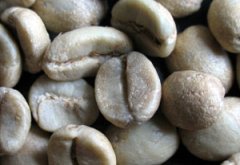Boutique coffee common sense coffee raw beans the difference between new beans and old beans
After dry and wet processing, coffee fruit becomes coffee raw bean (Raw bean/Green bean).
The main ingredients of raw beans are:
Carbohydrates, about 49%
Moisture, about 12%
Protein. About 11%
Chlorogenic acid, about 7.6%
Alkaloids and trace elements, about 0.4%.
According to the length of time, raw beans can be divided into:
Seasonal beans (Current Crop), that is, raw beans just harvested
New beans (New Crop), that is, raw beans in the first year
Old beans (Past Crop), that is, raw beans stored for two years
Old Crop, that is, raw beans that have been in stock for too long.
Aged beans (Aged Bean), unlike old beans, are stored in a unique way: wrapped in endocarp, stored in a high and cool warehouse of origin, and often turned over. After baking, the acid quality of the old bean flavor becomes weaker, the mellowness becomes higher, the texture becomes thicker, and the old bean can be integrated with the new bean to balance the acid quality. In addition, the aged beans after baking should be placed for 3 days after extraction and drinking, so that their thick flavor can be displayed.
In addition, compared with the old bean, the new bean is difficult to bake because of its high water content and difficult heat transfer. After baking, the new beans feel lively, with natural flower aroma, high-quality sour taste, high water content, rich chlorogenic acid, relatively bright and strong taste; old beans feel calm, mellow and thick, low water content, slightly expanded volume, soft taste.
With the growth of time, the internal moisture of raw beans gradually decreases, the color of raw beans will gradually change from dark green to blue to white and yellow; the smell of fresh fruit or grass will also gradually weaken; vitality will decrease. All these can be used as the basis to distinguish the freshness of raw beans.
New beans (new corp), newly harvested coffee beans, coffee beans are usually harvested at the end of the year, but in Chinese mainland, it is still a bit difficult to buy raw beans of the season; new coffee beans are high in water content, rich in chlorogenic acid and relatively distinctive and strong taste. The difficulty of baking new beans is greater, the water content is more, and the heat transfer performance is poor.
Old beans (old crop) are not coffee beans harvested in the season. The moisture of raw coffee beans is relatively easy to distribute. The new beans bought in March are green, and after a few months, they turn a little white and have some raised white spots on the surface. If they have been put for longer, they can be called Chen dou. The color is a little yellow, the water content is small, and the volume expands slightly. Coffee beans that have been kept for a long time are easier to heat transfer, easier to bake, and taste relatively soft. The amount of raw coffee beans of the same weight seems to be significantly higher than that of aged beans.
Generally speaking, new coffee beans are better, but some people also prefer old beans; they don't really know which one they like until they have experienced it.
Important Notice :
前街咖啡 FrontStreet Coffee has moved to new addredd:
FrontStreet Coffee Address: 315,Donghua East Road,GuangZhou
Tel:020 38364473
- Prev

How to choose coffee beans
The taste of raw beans and apples before selection will not vary according to their size. I agree with this sentence, but I disagree with the roasting of coffee beans. Anyway, they are all heated. It doesn't matter if the coffee beans vary in size. Coffee beans harvested from the same tree, regardless of size
- Next

Coffee beans recommend high quality Nicaraguan coffee
Nicaraguan coffee flavor characteristics: moderate acidity, fragrant and delicious. Nicaraguan coffee of high quality is in the forefront of coffee beans in the world and enjoys a good reputation. Its particles are moderate in size, mild in taste and very aromatic and mellow. Nicaragua is located in central Central America, bordered by the Pacific Ocean to the west and the Caribbean Sea to the east. The highland in the north and the coastal plain in the east, belonging to the Central American volcanic belt.
Related
- Beginners will see the "Coffee pull flower" guide!
- What is the difference between ice blog purified milk and ordinary milk coffee?
- Why is the Philippines the largest producer of crops in Liberia?
- For coffee extraction, should the fine powder be retained?
- How does extracted espresso fill pressed powder? How much strength does it take to press the powder?
- How to make jasmine cold extract coffee? Is the jasmine + latte good?
- Will this little toy really make the coffee taste better? How does Lily Drip affect coffee extraction?
- Will the action of slapping the filter cup also affect coffee extraction?
- What's the difference between powder-to-water ratio and powder-to-liquid ratio?
- What is the Ethiopian local species? What does it have to do with Heirloom native species?

